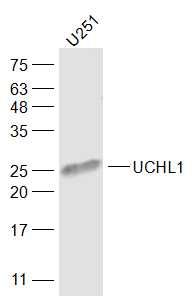产品中心
当前位置:首页>产品中心Anti-UCHL1
货号: bsm-51100M 基本售价: 860.0 元 规格: 50ul
- 规格:50ul
- 价格:860.00元
- 规格:100ul
- 价格:1580.00元
产品信息
- 产品编号
- bsm-51100M
- 英文名称
- UCHL1
- 中文名称
- 小鼠抗泛素硫酯酶L1单克隆抗体
- 别 名
- Gracile axonal dystrophy; Neuron cytoplasmic protein 9.5; Park 5; Park5; Parkinson Disease 5; PGP 9.5; PGP9.5; PGP95; Protein gene product 9.5; Ubiquitin C terminal esterase L1; Ubiquitin C terminal hydrolase (neuron specific); Ubiquitin C terminal hydrolase; Ubiquitin carboxyl terminal esterase L1; Ubiquitin carboxyl terminal hydrolase isozyme L1; Ubiquitin carboxyl-terminal hydrolase isozyme L1; Ubiquitin thioesterase L1; Ubiquitin thiolesterase; Ubiquitin thiolesterase L1; UCH L1; UCH-L1; UCHL1; UCHL1_HUMAN.
- 规格价格
- 50ul/860元购买 100ul/1580元购买 大包装/询价
- 说 明 书
- 50ul 100ul
- 研究领域
- 肿瘤 细胞生物 免疫学 神经生物学
- 抗体来源
- Mouse
- 克隆类型
- Monoclonal
- 克 隆 号
- 3C2
- 交叉反应
- Human,
- 产品应用
- WB=1:500-2000 IHC-P=1:20-200 IHC-F=1:20-200 ICC=1:100-500 IF=1:20-200 (石蜡切片需做抗原修复)
not yet tested in other applications.
optimal dilutions/concentrations should be determined by the end user.
- 分 子 量
- 25kDa
- 细胞定位
- 细胞浆 细胞膜
- 性 状
- Lyophilized or Liquid
- 浓 度
- 1mg/ml
- 免 疫 原
- Recombinant human UCHL1:
- 亚 型
- IgG1
- 纯化方法
- affinity purified by Protein G
- 储 存 液
- 0.01M TBS(pH7.4) with 1% BSA, 0.03% Proclin300 and 50% Glycerol.
- 保存条件
- Store at -20 °C for one year. Avoid repeated freeze/thaw cycles. The lyophilized antibody is stable at room temperature for at least one month and for greater than a year when kept at -20°C. When reconstituted in sterile pH 7.4 0.01M PBS or diluent of antibody the antibody is stable for at least two weeks at 2-4 °C.
- PubMed
- PubMed
- 产品介绍
- background:
The protein encoded by this gene belongs to the peptidase C12 family. This enzyme is a thiol protease that hydrolyzes a peptide bond at the C-terminal glycine of ubiquitin. This gene is specifically expressed in the neurons and in cells of the diffuse neuroendocrine system. Mutations in this gene may be associated with Parkinson disease.[provided by RefSeq, Sep 2009]
Function:
Ubiquitin-protein hydrolase involved both in the processing of ubiquitin precursors and of ubiquitinated proteins. This enzyme is a thiol protease that recognizes and hydrolyzes a peptide bond at the C-terminal glycine of ubiquitin. Also binds to free monoubiquitin and may prevent its degradation in lysosomes. The homodimer may have ATP-independent ubiquitin ligase activity.
Subcellular Location:
Cytoplasm. Endoplasmic reticulum membrane. About 30% of total UCHL1 is associated with membranes in brain.
Tissue Specificity:
Found in neuronal cell bodies and processes throughout the neocortex (at protein level). Expressed in neurons and cells of the diffuse neuroendocrine system and their tumors. Weakly expressed in ovary. Down-regulated in brains from Parkinson disease and Alzheimer disease patients.
Post-translational modifications:
O-glycosylated.
DISEASE:
Defects in UCHL1 are the cause of Parkinson disease type 5 (PARK5) [MIM:613643]; also known as Parkinson disease autosomal dominant 5. PARK5 is a complex neurodegenerative disorder with manifestations ranging from typical Parkinson disease to dementia with Lewy bodies. Clinical features include parkinsonian symptoms (resting tremor, rigidity, postural instability and bradykinesia), dementia, diffuse Lewy body pathology, autonomic dysfunction, hallucinations and paranoia.
Similarity:
Belongs to the peptidase C12 family.
SWISS:
P09936
Gene ID:
7345
Database links:Entrez Gene: 7345 Human
Entrez Gene: 22223 Mouse
Entrez Gene: 396637 Pig
Entrez Gene: 29545 Rat
Entrez Gene: 101117250 Sheep
Entrez Gene: 325119 Zebrafish
Omim: 191342 Human
SwissProt: P09936 Human
SwissProt: Q9R0P9 Mouse
SwissProt: Q6SEG5 Pig
SwissProt: Q00981 Rat
Unigene: 518731 Human
Unigene: 29807 Mouse
Unigene: 107213 Rat
Important Note:
This product as supplied is intended for research use only, not for use in human, therapeutic or diagnostic applications.
- 产品图片
 Sample:
Sample:
U251(Human) Cell Lysate at 30 ug
Primary: Anti-UCHL1 (bsm-51100M) at 1/1000 dilution
Secondary: IRDye800CW Goat Anti-Mouse IgG at 1/20000 dilution
Predicted band size: 25 kD
Observed band size: 25 kD

